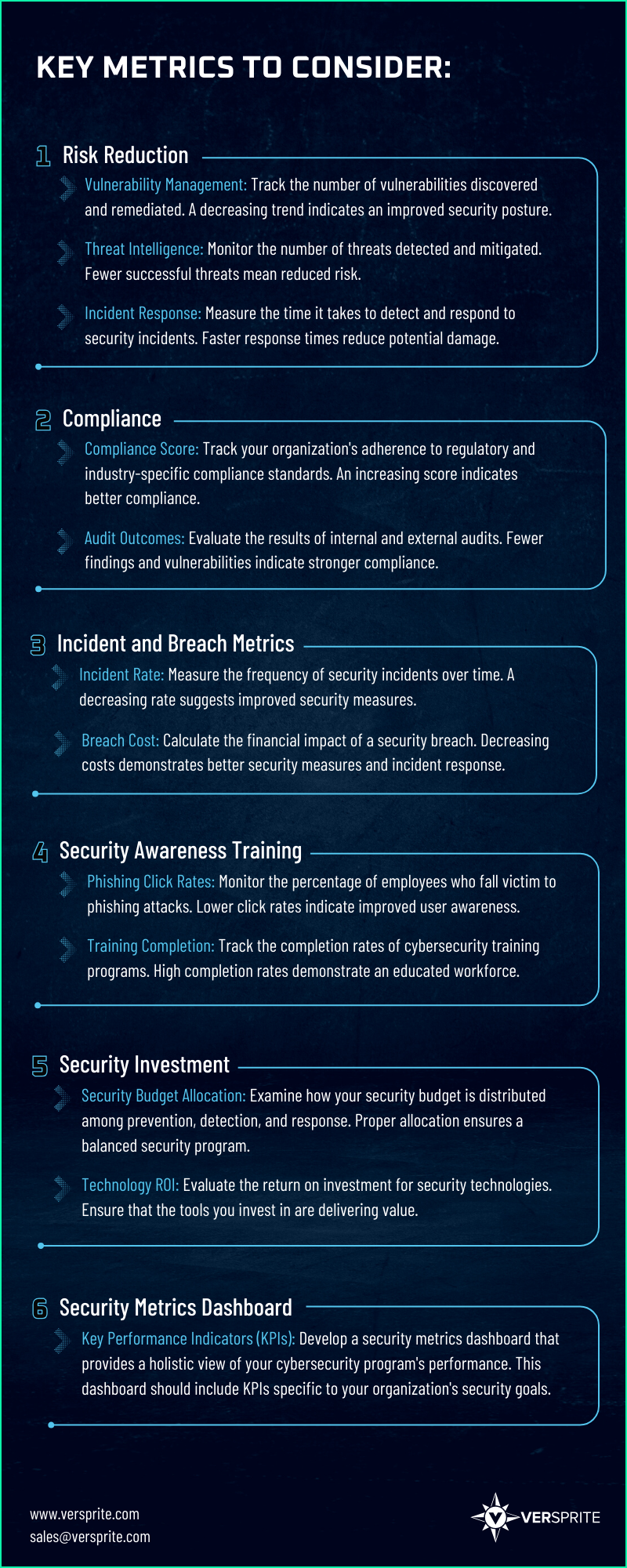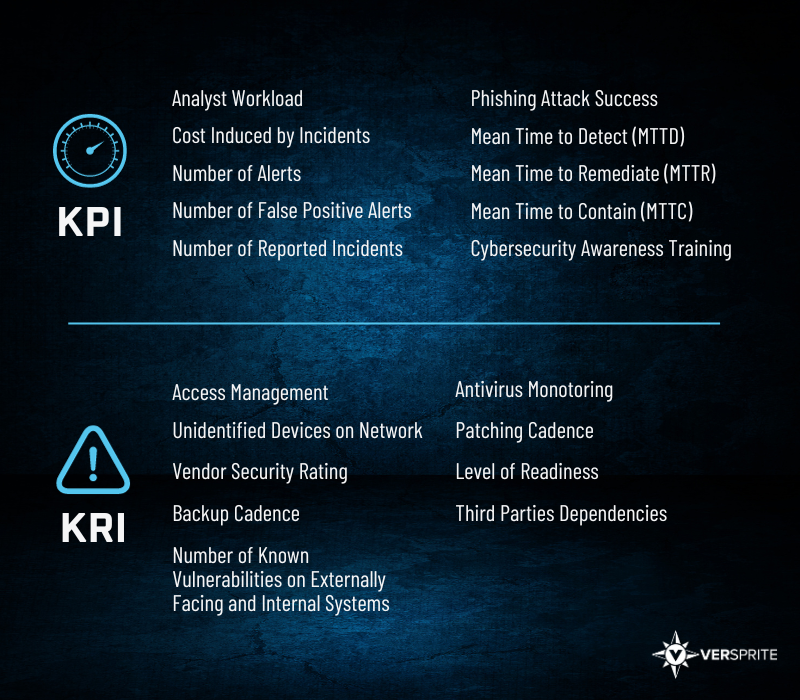Year-End Results: How to Measure the Success of Your Cybersecurity Program
How to Measure Cybersecurity Effectiveness – Cybersecurity Solutions for Businesses
A robust and effective cybersecurity program is critical for protecting sensitive data, ensuring business continuity, and maintaining trust with stakeholders. However, having a cybersecurity program in place is just the beginning. You need to measure the success of your cybersecurity program by focusing on certain factors.
Measuring its success is equally important to ensure that it delivers the expected results and adapts to the changing business goals and threat landscape. In this comprehensive guide, we’ll explore various metrics and strategies to help you measure the success of your cybersecurity program.
Why it’s Important to Measure the Success of Your Cybersecurity Program
Measuring the success of your cybersecurity program serves multiple purposes:
1. Continuous Improvement: It helps identify areas that need improvement, allowing you to refine your security measures and adapt to emerging threats.
2. Resource Allocation: Effective measurement ensures resources are allocated to the most critical security initiatives.
3. Demonstrating ROI: Measuring success can provide tangible evidence of the return on investment in your cybersecurity program, essential for securing budget approvals.
4. Compliance and Reporting: Many regulations and industry standards require organizations to measure and report on their cybersecurity efforts.
Key Metrics to Consider as You Measure the Success of Your Cybersecurity Program
To effectively measure the success of your cybersecurity program, you need to focus on a combination of quantitative and qualitative metrics.

BEST PRACTICES FOR MEASURING CYBERSECURITY PROGRAM SUCCESS
Measuring cybersecurity program success is not just about collecting data; it’s about adopting best practices that ensure the data you collect is accurate and actionable. Here are some best practices to follow:
1. Align Metrics with Business Goals
Ensure that the metrics you choose align with your organization’s overall business goals. This helps demonstrate the value of cybersecurity efforts in the context of the business.
For example, in a financial services company, the cybersecurity team aligned metrics with the organization’s business goal of enhancing customer trust and satisfaction. One metric tracked was the reduction in customer-reported security incidents over time. By focusing on this metric, the cybersecurity team directly contributed to the broader business goal of maintaining a secure and trustworthy financial environment for clients. This alignment helped showcase the tangible impact of cybersecurity efforts on the organization’s bottom line and customer relationships.
2. Consistency in Data Collection
Consistency is key. Ensure that you collect data regularly and consistently to track trends and changes over time.
Let’s take a manufacturing firm as an example. The firm implemented consistent data collection practices to monitor the effectiveness of its cybersecurity controls. By regularly logging and analyzing data related to network traffic, system access, and security incidents, the cybersecurity team identified patterns and anomalies. This consistent data collection approach enabled them to detect and respond to potential threats in a timely manner, showcasing the importance of sustained vigilance in maintaining a secure environment.
3. Define Baselines
Establish baseline values for your chosen metrics. This allows you to compare current performance against historical data to gauge improvement or regression.
In a healthcare organization, the cybersecurity team can establish baselines for metrics related to data breaches and unauthorized access to patient information. By comparing current performance against historical data, they will be able to identify a significant decrease in security incidents after implementing a multifactor authentication system. This baseline comparison demonstrates the cybersecurity program’s success and can inform future strategies to improve security measures continuously.
4. Benchmark Against Industry Standards
Compare your organization’s performance to industry benchmarks and standards. This provides context and helps you identify areas that need attention.
For example, a technology company regularly benchmarked its cybersecurity program against industry standards, such as the NIST Cybersecurity Framework. By conducting periodic assessments and comparing their security controls to recognized frameworks, the cybersecurity team gained insights into areas requiring improvement. This proactive approach not only enhanced the organization’s cybersecurity posture but also ensured compliance with industry best practices, providing a competitive advantage.
5. Establish Thresholds
Set clear thresholds for your metrics. For instance, determine what constitutes an acceptable incident response time or an acceptable compliance score.
In a retail chain, the cybersecurity team can set clear thresholds for metrics related to point-of-sale system security. One specific threshold can be established for acceptable vulnerability levels in these systems. If the vulnerability levels exceed the defined threshold, immediate remediation measures would be implemented. This proactive threshold-setting approach helps the organization maintain a secure retail environment and minimize the risk of potential breaches.
6. Include Qualitative Feedback
Don’t rely solely on quantitative data. Include qualitative feedback from security professionals, stakeholders, and end-users to gain a more comprehensive view of your cybersecurity program.
Taking an educational institution as an example. It sought qualitative feedback from end-users to supplement quantitative data. The security team conducted surveys and interviews to gather insights into user experiences with security measures, such as password policies and secure access protocols. Incorporating this qualitative feedback provided a more holistic understanding of the user perspective, allowing the cybersecurity team to implement user-friendly security measures that were both effective and well-received.
7. Regularly Review and Adjust
Cybersecurity is dynamic. Regularly review your metrics and adjust them to reflect changes in your organization, threat landscape, and technology.
For example, in the energy sector, a security team regularly reviews metrics in response to evolving threats and technology changes. As new vulnerabilities emerge and technology landscapes shifts, the team adjusts their metrics to ensure they remain relevant and align with the organization’s risk profile. This continuous review and adjustment process will allow the organization to stay ahead of emerging threats and adapt its cybersecurity program to the dynamic nature of the energy sector.
Challenges in Measuring Cybersecurity Success
Measuring cybersecurity program success is not without challenges. Here are some common obstacles and how to address them:
- Incomplete Data
Data may be incomplete due to various factors, including unreported incidents. Address this by encouraging a culture of transparency and incident reporting.
- Lack of Standardized Metrics
The cybersecurity industry lacks standardized metrics. Mitigate this by defining internal metrics that align with your organization’s specific goals and objectives.
- Data Overload
Collecting too much data can lead to data overload. Focus on key metrics that are most relevant to your organization’s goals.
- Short-Term vs. Long-Term Metrics
Some metrics are more focused on short-term results, while others provide insight into long-term trends. Balance your metrics to capture both perspectives.
- Difficulty in Attributing ROI
Attributing ROI directly to cybersecurity measures can be challenging. Use qualitative feedback, incident cost calculations, and risk reduction metrics to provide a more holistic view of ROI.
VERSPRITE CAN HELP
As organizations strive to measure and improve the success of their cybersecurity programs, partnering with a reputable cybersecurity firm can provide invaluable expertise and support. At VerSprite, we help our clients maximize their program’s ROI and strengthen their security posture. How do we do it?
VerSprite specializes in aligning cybersecurity goals to comprehensive security frameworks, ensuring organizations have a structured and strategic approach to security initiatives. By leveraging frameworks such as NIST, ISO 27001, or CIS, and developing PASTA threat model that aligns with the business objectives, we can establish a robust foundation for cybersecurity programs. We work closely with clients to integrate security programs seamlessly into their business strategic plans.
Providing a Quantitative Approach to Prioritize Goals
Quantifying the impact of cybersecurity efforts is crucial to measuring success and demonstrating ROI. VerSprite takes a quantitative approach to prioritize cybersecurity goals, ensuring that resources are allocated where they can have the most significant impact.
VerSprite uses risk quantification with Key Risk Indicators (KRIs) while measuring business performance with Key Performance Indicatiors (KPIs). Both are equally important in the comprehensive assessment of cybersecurity governance programs.

Measuring the success of your cybersecurity program is essential for ensuring that your organization is adequately protected and in compliance with regulatory standards. By selecting the right metrics, adopting best practices, and addressing common challenges, you can gain valuable insights into the effectiveness of your cybersecurity efforts. Remember that cybersecurity is an ongoing process, and regular measurement and adjustment are key to staying ahead of emerging threats and protecting your organization’s digital assets.
Concerned about the success of your cybersecurity program? VerSprite’s team can help! Contact us today.
- /
- /
- /
- /
- /
- /
- /
- /
- /
- /
- /
- /
- /
- /
- /
- /
- /
- /
- /
- /
- /
- /